Question #170
The solution must meet the following requirements:
• Item results from Azure Cosmos DS must return the most recent committed version of an item.
• Items written to Azure Cosmos DB must provide ordering guarantees.
You need to configure the consistency level for the Azure Cosmos DB deployments.
Which consistency level should you use?
Correct Answer:
D
Strong consistency in Azure Cosmos DB guarantees that reads will always reflect the most recent write operation, fulfilling the requirement for returning the most recent committed version of an item. This level ensures linearizability which is crucial for scenarios where accuracy and recency of the data are critical. However, it's worth noting that if the deployment extends to multiple write regions, strong consistency might not be achievable due to the inherent limitations in distributed systems. Thus, another consistency level like bounded staleness could be a better fit in multi-write region scenarios.
Question #171
-
You are developing an application that runs in several customer Azure Kubernetes Service clusters. Within each cluster, a pod runs that collects performance data to be analyzed later. A large amount of data is collected so saving latency must be minimized.
The performance data must be stored so that pod restarts do not impact the stored data. Write latency should be minimized.
You need to configure blob storage.
How should you complete the YAML configuration? To answer, select the appropriate options in the answer area.
NOTE: Each correct selection is worth one point.

Question #172
-
Case study
-
This is a case study. Case studies are not timed separately. You can use as much exam time as you would like to complete each case. However, there may be additional case studies and sections on this exam. You must manage your time to ensure that you are able to complete all questions included on this exam in the time provided.
To answer the questions included in a case study, you will need to reference information that is provided in the case study. Case studies might contain exhibits and other resources that provide more information about the scenario that is described in the case study. Each question is independent of the other questions in this case study.
At the end of this case study, a review screen will appear. This screen allows you to review your answers and to make changes before you move to the next section of the exam. After you begin a new section, you cannot return to this section.
To start the case study
-
To display the first question in this case study, click the Next button. Use the buttons in the left pane to explore the content of the case study before you answer the questions. Clicking these buttons displays information such as business requirements, existing environment, and problem statements. When you are ready to answer a question, click the Question button to return to the question.
Background
-
VanArsdel, Ltd. is a global office supply company. The company is based in Canada and has retail store locations across the world. The company is developing several cloud-based solutions to support their stores, distributors, suppliers, and delivery services.
Current environment
-
Corporate website
-
The company provides a public website located at http://www.vanarsdelltd.com. The website consists of a React JavaScript user interface, HTML, CSS, image assets, and several APIs hosted in Azure Functions.
Retail Store Locations
-
The company supports thousands of store locations globally. Store locations send data every hour to an Azure Blob storage account to support inventory, purchasing and delivery services. Each record includes a location identifier and sales transaction information.
Requirements
-
The application components must meet the following requirements:
Corporate website
-
• Secure the website by using SSL.
• Minimize costs for data storage and hosting.
• Implement native GitHub workflows for continuous integration and continuous deployment (CI/CD).
• Distribute the website content globally for local use.
• Implement monitoring by using Application Insights and availability web tests including SSL certificate validity and custom header value verification.
• The website must have 99.95 percent uptime.
Retail store locations
-
• Azure Functions must process data immediately when data is uploaded to Blob storage. Azure Functions must update Azure Cosmos DB by using native SQL language queries.
• Audit store sale transaction information nightly to validate data, process sales financials, and reconcile inventory.
Delivery services
-
• Store service telemetry data in Azure Cosmos DB by using an Azure Function. Data must include an item id, the delivery vehicle license plate, vehicle package capacity, and current vehicle location coordinates.
• Store delivery driver profile information in Azure Active Directory (Azure AD) by using an Azure Function called from the corporate website.
Inventory services
-
The company has contracted a third-party to develop an API for inventory processing that requires access to a specific blob within the retail store storage account for three months to
include read-only access to the data.
Security
-
• All Azure Functions must centralize management and distribution of configuration data for different environments and geographies, encrypted by using a company-provided RSA-HSM key.
• Authentication and authorization must use Azure AD and services must use managed identities where possible.
Issues
-
Retail Store Locations
-
• You must perform a point-in-time restoration of the retail store location data due to an unexpected and accidental deletion of data.
• Azure Cosmos DB queries from the Azure Function exhibit high Request Unit (RU) usage and contain multiple, complex queries that exhibit high point read latency for large items as the function app is scaling.
You need to implement the delivery service telemetry data.
How should you configure the solution? To answer, select the appropriate options in the answer area.
NOTE: Each correct selection is worth one point.
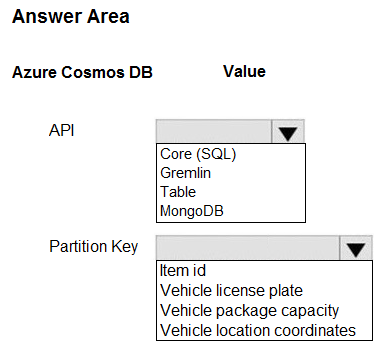
Question #173
-
You are developing several microservices to run on Azure Container Apps. External HTTP ingress traffic has been enabled for the microservices.
A deployed microservice must be updated to allow users to test new features. You have the following requirements:
• Enable and maintain a single URL for the updated microservice to provide to test users.
• Update the microservice that corresponds to the current microservice version.
You need to configure Azure Container Apps.
Which features should you configure? To answer, select the appropriate options in the answer area.
NOTE: Each correct selection is worth one point.
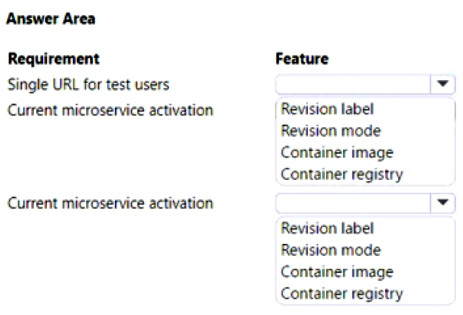
Question #174
User authentication and authorization must use Azure Active Directory (Azure AD).
You need to configure authentication and authorization.
What should you do first?
Question #175
-
You have an Azure Cosmos DB for NoSQL account.
You plan to develop two apps named App1 and App2 that will use the change feed functionality to track changes to containers. App1 will use the pull model and App2 will use the push model.
You need to choose the method to track the most recently processed change in App1 and App2.
Which component should you use? To answer, drag the appropriate components to the correct apps. Each component may be used once, more than once, or not at all. You may need to drag the split bar between panes or scroll to view content.
NOTE: Each correct selection is worth one point.

Question #176
-
You plan to develop an Azure Functions app with an HTTP trigger.
The app must support the following requirements:
• Event-driven scaling
• Ability to use custom Linux images for function execution
You need to identify the app’s hosting plan and the maximum amount of time that the app function can take to respond to incoming requests.
Which configuration setting values should you use? To answer, select the appropriate values in the answer area.
NOTE: Each correct selection is worth one point.
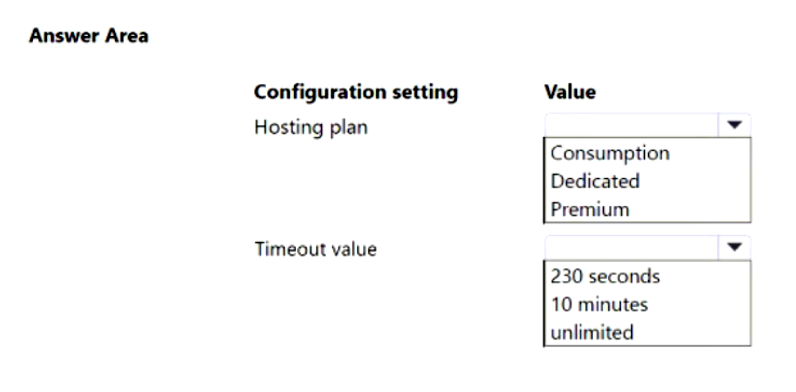
Question #177
-
You develop a Python application for image rendering. The application uses GPU resources to optimize rendering processes.
You have the following requirements:
• The application must be deployed to a Linux container.
• The container must be stopped when the image rendering is complete.
• The solution must minimize cost.
You need to deploy the application to Azure.
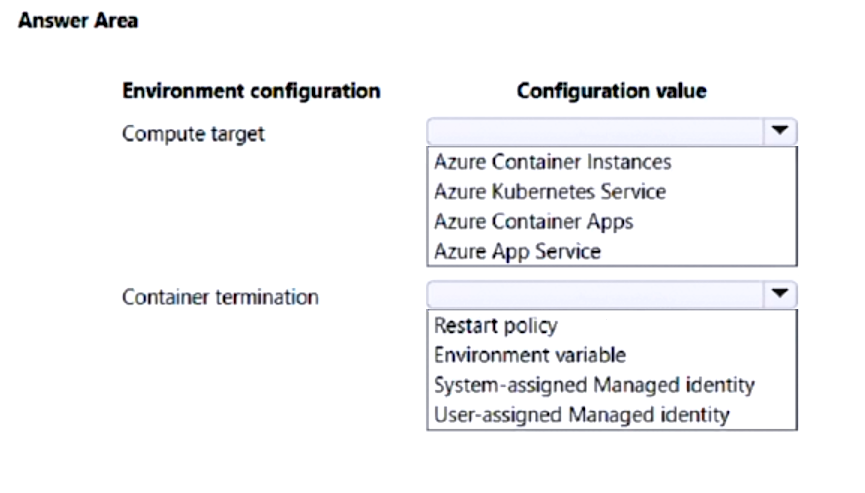
Question #178
-
You plan to develop an Azure Functions app with an Azure Blob Storage trigger. The app will be used infrequently, with a limited duration of individual executions.
The app must meet the following requirements:
• Event-driven scaling
• Support for deployment slots
• Minimize costs
You need to identify the hosting plan and the maximum duration when executing the app.
Which configuration setting values should you use? To answer, select the appropriate values in the answer area.
NOTE: Each correct selection is worth one point.
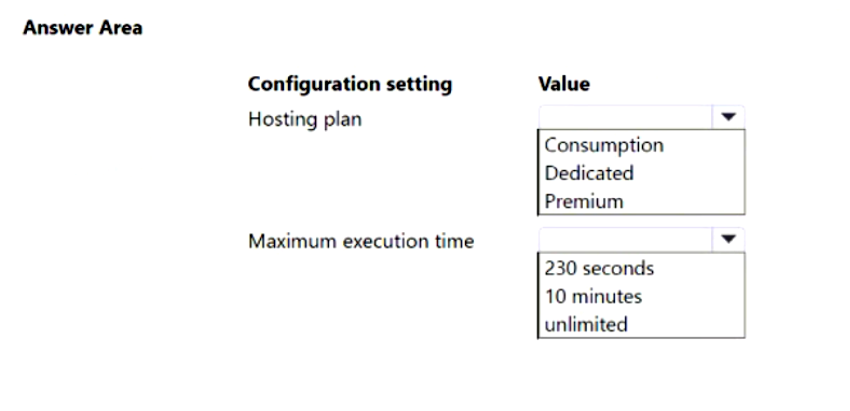
Question #179
You are not permitted to make changes to the application.
Some customer sites only have phone-based internet connections.
You need to configure the console application to access the images.
What should you use?
Azure BlobFuse is indeed the ideal choice in this scenario, not Azure Storage NFS 3.0 support. BlobFuse enables Linux containers to access Azure Blob Storage as if it were part of the local file system. This is critical since the application itself cannot be modified, and BlobFuse offers a seamless integration without needing changes to existing applications, facilitating smooth file access even under limited internet connectivity conditions. This solution ensures the application remains unchanged while still accessing the required data efficiently.
Question #180
-
You are developing several microservices named serviceA, serviceB, and serviceC. You deploy the microservices to a new Azure Container Apps environment.
You have the following requirements:
• The microservices must persist data to storage.
• serviceA must persist data only visible to the current container and the storage must be restricted to the amount of disk space available in the container.
• serviceB must persist data for the lifetime of the replica and allow multiple containers in the replica to mount the same storage location.
• serviceC must persist data beyond the lifetime of the replica while allowing multiple containers to access the storage and enable per object permissions.
You need to configure storage for each microservice.
Which storage type should you use? To answer, drag the appropriate storage types to the correct microservices. Each storage type may be used once, more than once, or not at all. You may need to drag the split bar between panes or scroll to view content.
NOTE: Each correct selection is worth one point.
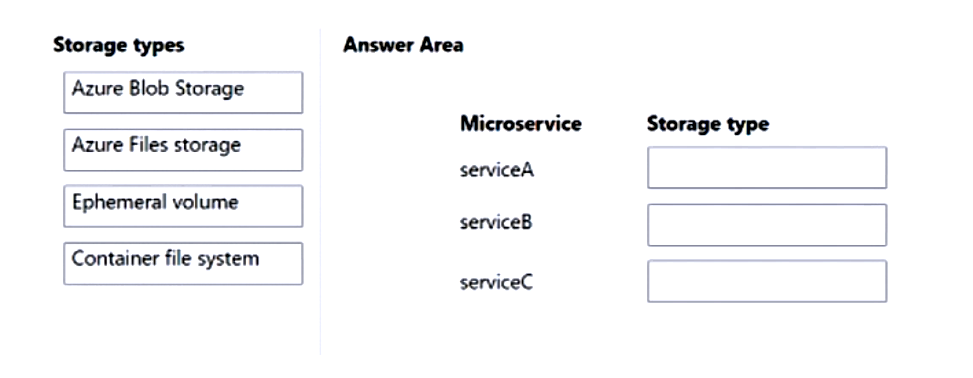
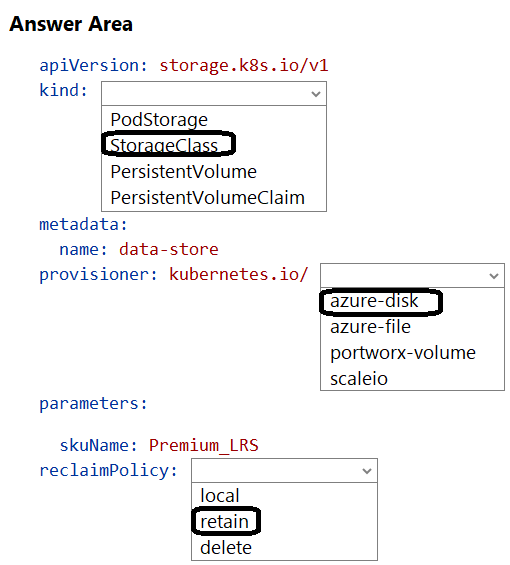
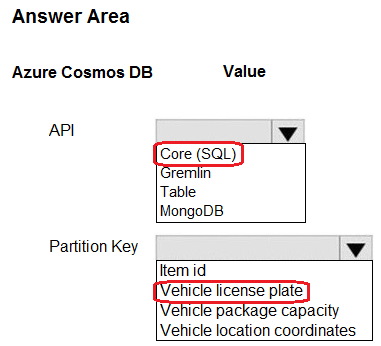
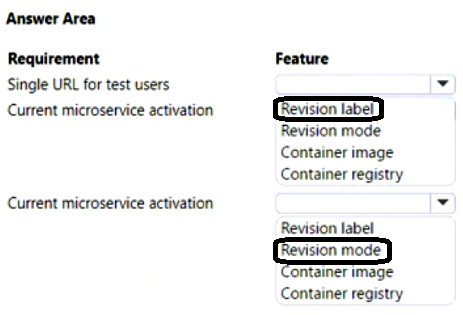

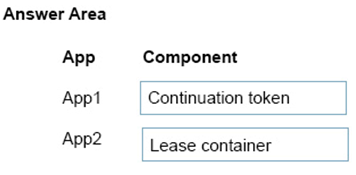
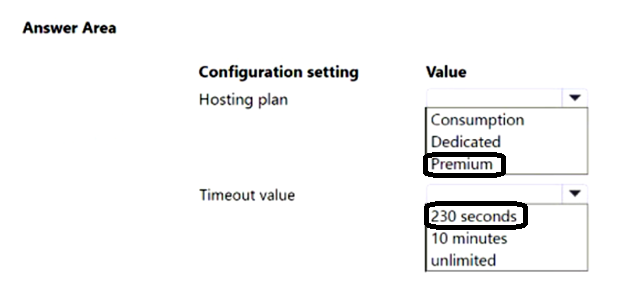
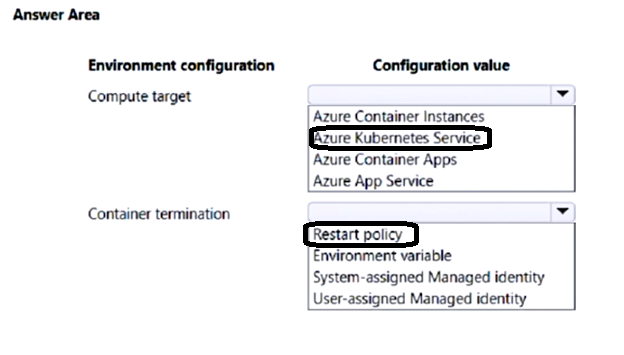
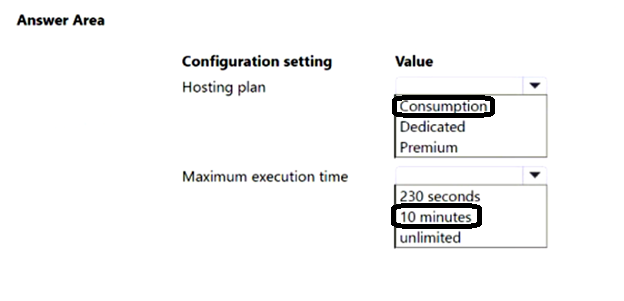
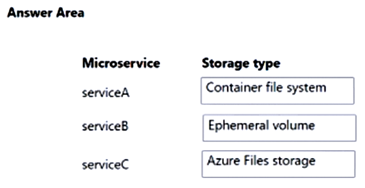
No comments:
Post a Comment